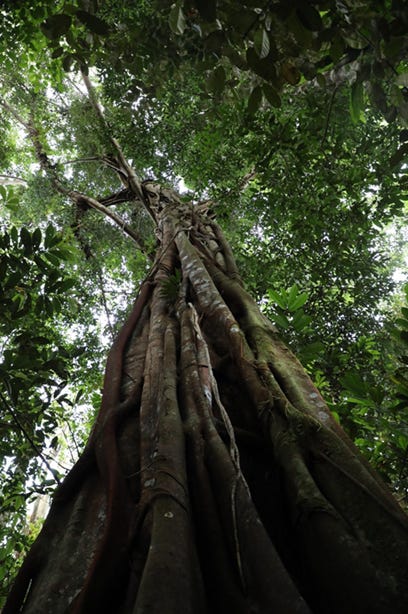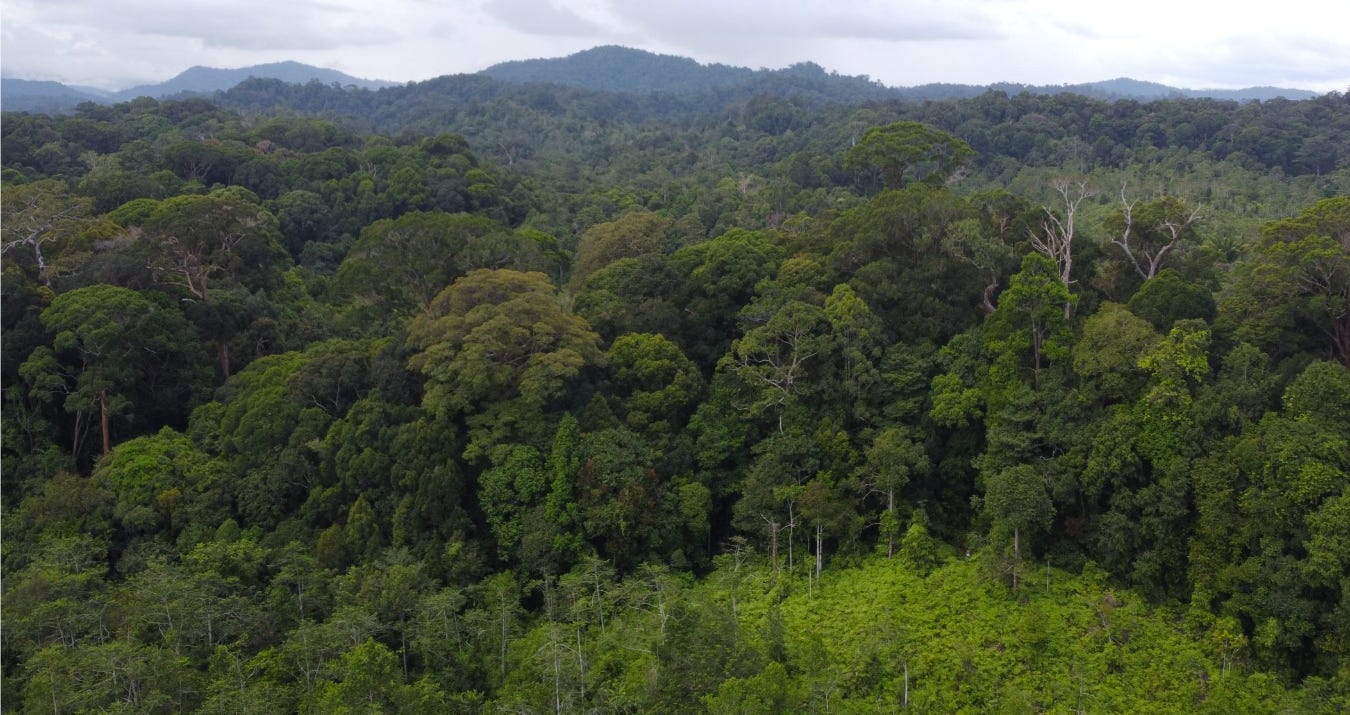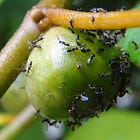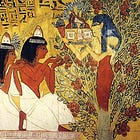Deep in a Bornean rainforest, the antu grasi lurks among the aerial roots of a large strangler fig. The Indigenous Iban people say this fearsome spirit can bring sickness or death to anyone who harms its tree. So they leave the strangler figs alone. But their taboo does more than appease unseen forces — it shapes the forest itself.
A new study published in Biotropica reveals how these beliefs guide daily life in Sungai Utik, an Iban community in West Kalimantan, in the Indonesian part of Borneo. The people there protect and manage nearly 9,500 hectares of forest, periodically clearing small areas for crops and allowing forest to regenerate in fallow fields.
Ditro Wibisono Wardi Parikesit and colleagues interviewed 32 members of the community and learned how a fear of supernatural consequences ensures that towering strangler figs remain unharmed, even when land is cleared and burned. This respect for spirits has profound side-effects on the wider ecosystem.

Spirits and reciprocity
Most of the community are Roman Catholics who also hold on to ancestral beliefs. Catholicism arrived in the 1970s, but rather than replacing the Iban cosmology, it intertwined with it. Local priests may incorporate traditional rituals into the Catholic mass, seeing them as complementary, rather than contradictory.
In this context of blended beliefs, the community members regard large strangler figs (Ficus species) as the dwellings of various types of spirit — some malevolent, others harmless unless provoked. They say that the larger the strangler fig, the more numerous and powerful are its resident spirits.
To harm such a tree is to upset the cosmic balance and invite menawa — a concept that cannot be translated neatly into English. It represents a threat or curse and implies a moral reciprocity between people and nature. In other words: disrespect spirits, expect consequences.
Stories reinforce the taboo. Villagers told Ditro about a grandmother who died after damaging a strangler fig, and a young boy whom spirits lured away from his mother. They described rituals they use to placate the spirits if a fig tree is harmed accidentally.
Keystone figs
Strangler figs begin as seeds deposited in the forest canopy by fruit-eating animals. Their roots descend to the ground, eventually encasing their host tree. Across the tropics, these plants are ecological keystones, as some trees can be found with ripe figs at any time of year — sustaining dozens of bird and mammal species through times when other fruit is scarce.

The Iban have long benefitted from this abundance. For generations, Iban hunters kept watch beneath fruiting figs, knowing that primates, plump green pigeons, bearded pigs and many other species would come to feed — either in the canopy or on fallen figs. Such practices are rarer today, as regulations and the availability of shop-bought meat have reduced hunting. But thanks to the taboo, the bond between people and fig trees endures.
If a large strangler fig is living on land that villagers want to clear to grow rice or vegetables, they will first conduct a ritual with offerings at the tree. They will spare not only the fig tree but also an island of vegetation extending ten metres beyond its crown — which itself can range from 4 to 42 metres in diameter. The rest of the plot is cleared and burned to revitalize the soil, but the fig and its spirits are untouched.
Together, these living islands protect about 1.4 percent of the community’s farmland. While each is small in area, they are disproportionately rich in life — the strangler figs and their surrounding vegetation provide habitat for hundreds of species. The islands are refuges, stepping stones between habitat patches – and, when the figs ripen, vital food sources for birds and mammals.
And when it is time to let a field lie fallow, the presence of a strangler fig will hasten its return to forest by attracting such seed-dispersing animals. Through their respect for the traditional taboo, the community preserves micro-reserves of biodiversity across the agricultural landscape.
The taboo’s future
“The taboo remains largely secure but shows early signs of erosion,” says Ditro. Most of the people he interviewed (94 percent) uphold it. But two of them — one a local elder, deeply committed to Catholic doctrine and dismissive of superstition, the other a priest who married into the community — reject the ideas of spirits in trees. Both said they had cut down large strangler figs without suffering misfortune.
Ditro told me that younger members of the community who leave Sungai Utik for education sometimes question the old rules, but many still avoid harming a tree they feel might be watching them.
“The continuation of the taboo therefore depends on the persistence of spiritual significance and ritual practice in daily life,” says Ditro. “As long as respect toward spirits remains central, the taboo is likely to endure.”
Bridging worldviews
Ditro sees opportunities for conservation science and Iban cosmology to combine to ensure continued protection of ecologically important fig trees. He argues that effective conservation must begin with deep cultural understanding, empathy and trust, and lead to genuine community participation in research processes and integration of knowledge systems.
He advocates integrating ecological and genetic studies with local systems of naming and perceiving species, so that traditional and scientific knowledge complement each other.
“Sharing ecological findings in ways that resonate with the community’s spiritual understanding of strangler figs can deepen local engagement and strengthen protection efforts,” he told me. “Ultimately, by aligning ecological science with cultural meaning, the conservation of strangler figs can serve not only as an environmental initiative but also as a means of sustaining cultural continuity.”
Whether to appease spirits or to safeguard keystone resources, sparing a strangler fig has the same outcome — protecting the tree protects life all around it.

Thanks for reading. I have many more astounding stories about fig trees in the pipeline. If you’ve found value in my work here, your support — whether through sharing the newsletter, commenting or becoming a paid subscriber — will help keep this project growing.








Great story.
Fascinating. Thanks for sharing, Mike.